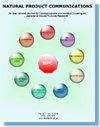红木(Vigna angularis)多酚对小鼠和 Caco-2 细胞的潜在降血糖作用
IF 1.4
4区 医学
Q4 CHEMISTRY, MEDICINAL
引用次数: 0
摘要
背景/目的包括赤小豆在内的一些有益健康的食物具有降血糖作用。从赤豆中提取的多酚类物质,如(+)-儿茶素 7- O- β-d-吡喃葡萄糖苷(C7G)和(+)-表儿茶素 7- O- β-d-吡喃葡萄糖苷(E7G),可能是α-淀粉酶和α-葡萄糖苷酶的潜在抑制剂。因此,我们使用小鼠和 Caco-2 细胞评估了含有多酚的粗赤豆提取物(ABP)和纯化的 C7G 或 E7G 的降血糖作用。方法给六周大的雄性 ICR 小鼠口服 ABP(100 或 250 毫克/千克)、C7G 或 E7G(15 或 40 毫克/千克)和蔗糖(2 克/千克)。从侧尾静脉抽取血液样本,以测量 0-120 分钟内不同时间的血糖水平。用 ABP、C7G 或 E7G 处理培养的肠道模型 caco-2 细胞。测量培养基中的葡萄糖浓度,以检查α-葡萄糖苷酶的活性。结果给药赤藓红多酚可降低血糖水平,尤其是给药 E7G 显著显示出体内抗高血糖作用。在 Caco-2 细胞中,ABP、C7G 或 E7G 的添加以剂量依赖的方式显著降低了 α-葡萄糖苷酶的活性,且无细胞毒性。结论这些结果表明,赤小豆提取物中的 C7G 和 E7G 可抑制蔗糖降解酶,从而在体内产生降血糖作用,这支持了之前使用赤小豆进行研究的结果,并可能有助于促进健康。本文章由计算机程序翻译,如有差异,请以英文原文为准。
Potential Antihyperglycemic Effects of Adzuki (Vigna angularis) Polyphenols on Mice and Caco-2 Cells
Background/PurposeSome health-beneficial foods, including adzuki beans ( Vigna angularis), can show antihyperglycemic effects. Adzuki bean-derived polyphenols, such as (+)-catechin 7- O- β-d-glucopyranoside (C7G) and (+)-epicatechin 7- O- β-d-glucopyranoside (E7G), could be potential inhibitors of α-amylase and α-glucosidase, however, few studies of the activity of adzuki polyphenols have been performed in vivo. Thus, we evaluated the antihyperglycemic effects of crude adzuki bean extract containing polyphenols (ABP), and purified C7G or E7G using mice and Caco-2 cells.MethodsSix-week-old male ICR mice were orally administered ABP (100 or 250 mg/kg), C7G or E7G (15 or 40 mg/kg), and sucrose (2 g/kg). Blood samples were taken from the lateral tail vein to measure the blood glucose levels at various times over 0–120 min. Cultured caco-2 cells, an intestinal model, were treated with ABP, C7G, or E7G. The glucose concentration in the medium was measured to examine the activity of α-glucosidase.ResultsAdministration of adzuki polyphenols decreased blood glucose levels, especially E7G administration significantly showed antihyperglycemic effects in vivo. In Caco-2 cells, α-glucosidase activity was significantly decreased by ABP, C7G, or E7G addition in a dose-dependent manner without cytotoxicity.ConclusionThese results suggest that C7G and E7G in adzuki bean extract inhibited sucrose-degrading enzymes to elicit antihyperglycemic effects in vivo, which supports the results of previous studies using adzuki beans, and may contribute to health promotion.
求助全文
通过发布文献求助,成功后即可免费获取论文全文。
去求助
来源期刊

Natural Product Communications
工程技术-食品科技
CiteScore
3.10
自引率
11.10%
发文量
254
审稿时长
2.7 months
期刊介绍:
Natural Product Communications is a peer reviewed, open access journal studying all aspects of natural products, including isolation, characterization, spectroscopic properties, biological activities, synthesis, structure-activity, biotransformation, biosynthesis, tissue culture and fermentation. It covers the full breadth of chemistry, biochemistry, biotechnology, pharmacology, and chemical ecology of natural products.
Natural Product Communications is a peer reviewed, open access journal studying all aspects of natural products, including isolation, characterization, spectroscopic properties, biological activities, synthesis, structure-activity, biotransformation, biosynthesis, tissue culture and fermentation. It covers the full breadth of chemistry, biochemistry, biotechnology, pharmacology, and chemical ecology of natural products.
Natural Product Communications is a peer reviewed, open access journal studying all aspects of natural products, including isolation, characterization, spectroscopic properties, biological activities, synthesis, structure-activity, biotransformation, biosynthesis, tissue culture and fermentation. It covers the full breadth of chemistry, biochemistry, biotechnology, pharmacology, and chemical ecology of natural products.
 求助内容:
求助内容: 应助结果提醒方式:
应助结果提醒方式:


